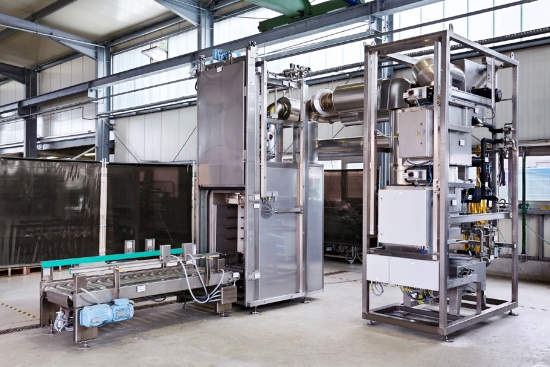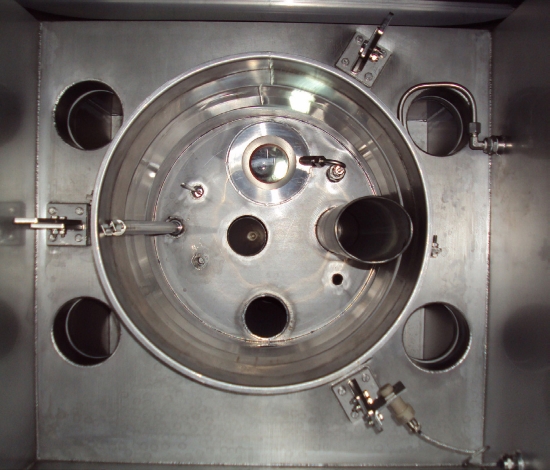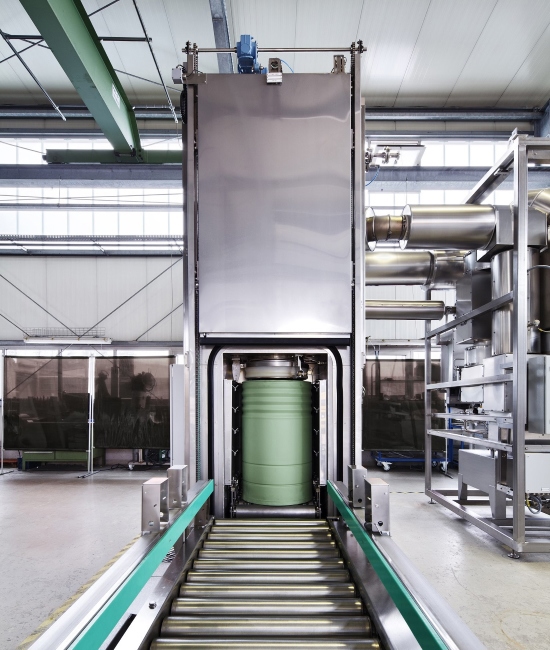Background
Drying processes are used for volume reduction of liquid radioactive waste. The final product of this process is a solid waste product.
The Westinghouse in-drum dryer dries liquid, non-combustible waste such as evaporator concentrates. During the drying process the solid content in the drum increases and precipitates while the liquid is evaporated and condensed subsequently. By falling below a certain drum filling level, liquid waste is automatically re-dosed. The drying process is complete once a certain condensate flow is no longer reached. The result is a quality dry product that can withstand long-term storage without chemical or biochemical reactions occurring over the subsequent storage period.

In-drum dryer
Description
The in-drum dryer consists of a drying chamber, air circulation system with air heater and cooler, condensation system and an automatically controlled feeding sluice. By default, the liquid waste is dried in 160-liter, 180-liter or 200-liter drums, although other geometries are possible. The open and empty drum is loaded into the drying chamber and lifted to the fill head by remote control.
Feeding of the drum with liquid waste is performed automatically by the feeding sluice which is connected to the circulation system and corresponding tank. Redundant level measurement guarantees that the drum will not be overcharged. The drum is heated by hot air that is provided by an air recirculation system. The airflow inside the drying chamber is optimized with regard to uniform air distribution and heating of the docked drum.
During the drying process, the liquid is evaporated, extracted via a separate steam pipe and condensed in the subsequent condenser. The solid content in the drum increases and finally starts to precipitate by reaching the specific solubility limit. Liquid waste will be continuously and automatically re-dosed by falling below a certain drum filling level. The end of the drying process is determined automatically by monitoring of the drum level and condensate measurement. Once the drying phase is finished, the cooling process begins. Total drying times vary depending on the moisture content and the composition of the waste. The residual moisture content of the dried product is below four weight percent.

In-drum dryer fill head
Because of the high tightness of the drying chamber and sealed docked drum under sub-pressure, no aerosols can exhaust to the environment. The dryer is operated from a separate control panel. System control is provided by a user-programmable logic controller. The entire drying process is permanently controlled and monitored in fully automatic operation. The floating contacts for process signals and centralized fault indications are available on a terminal strip in the control cubicle. All process variables are recorded automatically.
Benefits
The Westinghouse in-drum dryer offers a fully remote-controlled way for high-volume reduction of liquid radioactive waste. No direct operator interaction during loading, processing or unloading is necessary. The process does not create any secondary waste and the final product is a dry, stable waste form, inside of a standard drum.
For transporting, the drum can be handled with the usual auxiliary systems. The in-drum dryer can be used as a stand-alone system or as part of an integrated waste treatment facility. The drying chamber and the process skid are designed for maximum building layout flexibility, allowing customized layouts or easy integration into existing building structures. The automatic drum refilling ensures maximum volume use of the waste drum or precise and defined waste filling, if required. The Westinghouse in-drum dryer offers the following benefits:
- Automatic and remote-controlled drum transfer
- Sealed docking of drum with sub-pressure inside
- Liquid feed from continuous circulation
- Automated drying of liquids such as concentrates
- Separated heating and evaporation zone
- Heating with hot air (100 - 190 C)
- Collection of condensate for release or processing
- Skid unit and drying chamber unit
- Completely filled drum or defined filing
- Optional sampling device for dry residuals
Experience
Westinghouse has delivered in-drum dryer systems to various nuclear power plants in Germany, and recently to a large waste treatment center in China.

In-drum dryer transfer system




